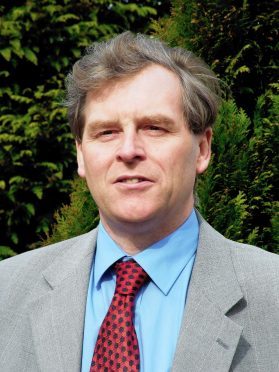Scottish livestock enterprises are still stubbornly typified by a top third of producers who consistently outperform the rest.
Stuart Ashworth, Head of Information Services at Quality Meat Scotland (QMS) refused yesterday to describe the findings as depressing and felt there was some movement towards better performance across the board.
He made the comments as he launched the QMS 2015 Enterprise Costings document ahead of its general release tomorrow at Agriscot. It is important to realise at the outset that this survey reflects the 2014 calf and lamb crops and the financial conditions in the calendar year.
“We noticed the top third edging away in 2013 but in 2014 the average performance improved a bit which is pleasing,“ he said. He did admit however that generally benign weather in 2014 would have helped.
“A little bit of luck, does help,“ he added. “But top producers continue to be characterised by high physical or technical performance, strong control over costs, and maximising returns from the market place.”
Using the suckler herds surveyed as an example, those in the top third of gross margin per animal achieved higher output through higher calf rearing percentages, combined with selling heavier calves resulting in higher yield per cow in the herd.
They also typically received 6 to 10 pence per kilogram liveweight more for the calves they sold. Those in the top third also had lower total variable costs than the average while achieving higher output.
“Variable costs per kilogram of calf reared were lower among the top third and fixed costs were also firmly controlled. In all cases top third producers had lower fixed costs per kilogram of output even if, on occasion, fixed cost per cow was higher than the average,” Mr Ashworth added.
Turning to the sheep sector he noted top-third producers achieving higher outputs by typically rearing between seven and 15 more lambs per 100 ewes than the average.
“Although they did not necessarily rear lambs to the heaviest weights, the larger lamb crop typically resulted in top-third flocks selling five kilogram liveweight more lamb per ewe. They also typically sold the highest proportion of lambs for immediate slaughter. The net effect of this was that income per ewe from lamb sales was £13 to £14 per ewe more than the average,” said Mr Ashworth.
The wide gap between the best and the poorest producers has now been repeatedly documented in these QMS surveys but Mr Ashworth refused to be overly pessimistic.
“We are seeing more people coming forward to meetings and showing more interest in the challenge of better resource efficiency,” he said.
“There was some churn in the survey with producers dropping out of the top league to be replaced by others and often this was result of better selection of breeding stock.”
One of the other distinguishing factors for top producers was a better understanding and compliance with abattoir requirements.
Mr Ashworth acknowledged that this was not always easy but said those who were most successful kept up a regular dialogue with buyers. For example if they were aware of queues building up in times of oversupply they would book in cattle three or four weeks early. “People who don’t do that find it much more difficult to meet specifications, “ he said.
There is however no concealing the effects of market volatility on top of historically low base prices. A worryingly high proportion of cattle and sheep producers relied heavily on support payments in 2014.
“Only 29% of store cattle finishers achieved a positive net margin, down from 72% the previous year, while among rearer-finishers the number achieving positive margins halved in comparison to 2013,” Mr Ashworth said.
The position was similar with store cattle producers where only one third achieved a positive net margin.
Amongst hill ewe flocks the proportion making a positive net margin lifted from 10% in 2013 to 15% in 2014. Upland flocks fared better with 68% in positive territory.
Hard copies of the QMS Enterprise Costings survey will be available at the QMS stand at Agriscot, or by post or on-line.
